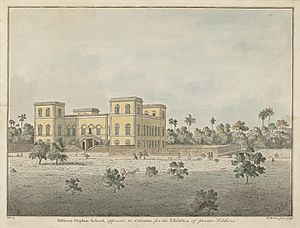William Baillie (artist) facts for kids
William Baillie (born 1752 or 1753, died 1799) was a British artist. He lived and worked in India during the late 1700s.
William Baillie's Life and Art
William Baillie was born in either 1752 or 1753. In 1777, he traveled to India. He joined the Bengal Infantry as a cadet. A cadet is a young person training to become an officer.
In 1778, he moved to the Engineers. This group focused on building and mapping. He helped survey, or map out, the Hooghly River.
In 1785, Baillie took a break from the army. The next year, he started a weekly newspaper. It was called the Calcutta Chronicle. He left the army completely in 1788. He wanted to become a full-time artist.
However, in 1792, he took on new roles. He became secretary of the Free School Society in Calcutta. He also became the superintendent of the school. In the same year, he published a map. It was called "Plan of Calcutta." This map was a smaller version of one made by Lt. Col. Mark Wood.
In 1794, Baillie released a set of prints. These were hand-colored aquatints. Aquatints are a type of printmaking that looks like watercolor paintings. The set was titled Twelve Views of Calcutta. Each print was about 15 by 11 inches. They were advertised as looking like "stained drawings."
He planned another set of eight prints. These would show the ruins of Gour and Rajmehal. They were announced as finished in 1798. But no copies of these prints have been found.
In 1795, Baillie wrote a letter. He told his friend, artist Ozias Humphry, about his work. He felt he had spent too much time painting landscapes. He said it was "a pleasing pursuit." But he added it was "not a pot-boiling one." This meant it didn't earn him much money. William Baillie died in Calcutta in 1799. He was 46 years old.


